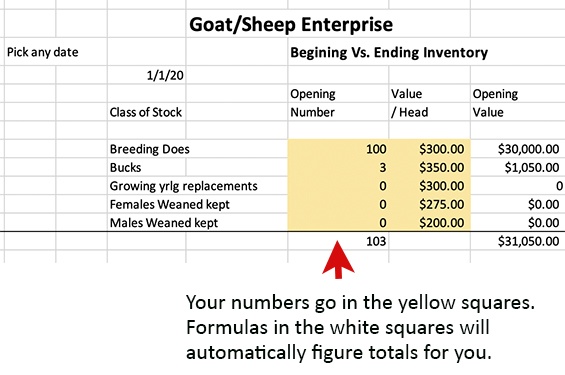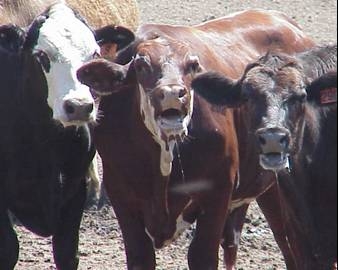
This week, Greg Christiansen of Grandview Grain and Livestock comes to us from his kitchen/office to share the Gross Margin spreadsheet he developed for his goat/sheep enterprise. While he uses his meat goat herd to demonstrate how he uses it, it works for other livestock as well.
What is Gross Margin per Unit and Why do We Care?
John Marble wrote an excellent article about paying attention to margins to ensure profitability. In it he defines gross margin as the cost of keeping breeding animals alive through the year. When we subtract that number from the money we make for selling kids, lambs, calves, etc., we have our margin. That’s the money we use to pay our overheads (land, labor and other indirect costs). We care because if our gross margin doesn’t cover those, we’re out of business.

A Walk Through the Spreadsheet

Greg starts by figuring the value of his inventory at the beginning of the year. For him, that’s March when he brings the nannies and kids in for vaccinations and hoof cleaning. Your start date can be any day you choose.
For this example he enters the number of breeding does and bucks he has, and then the value per animal. In this case he has 100 breeding does at $300 each and four bucks at $350 each. Yes, he says, you can go to the sale barn and buy does for $150, but within a couple of years only half of them will have survived or given you offspring. He’s talking about a fair price for quality, ranch-raised nannies. In some areas they might go for as much as $400 each.

Next we’ll look at the end of the year inventory starting with the animals that are now in the herd. In Greg’s example, three does died, leaving a total of 97. The four bucks are still in the herd and you’ve added 45 weaned doelings as replacements valued at $200. You had males and maybe some doelings that weren’t right for your herd, and you’ve sold all of them, so they don’t appear in this ending inventory. If you bought any additional animals you would add them here. Your closing inventory value is $39,500.

Now let’s look at sales. We start with the value of our closing inventory at the top and enter our sales and purchases in the yellow square. Let’s say you had 50 kids you took to the sale barn and sold for $150. If you purchased any animals, you would add them here as well. But for this example, we don’t buy anything, so we’ll leave that blank. The spreadsheet automatically figures your gross product, using this formula:
(Closing inventory + Sales) – (Purchases + Beginning Inventory)

Next we have to figure expenses. In the feed and supplement section, Greg’s spreadsheet prompts you to add in the number of animals and what you’re feeding them. He includes a protein supplement, a supplement for kids, hay to feed the animals when they’re not grazing, and mineral. You can see his numbers below. Don’t forget to fill in the number of days you’re providing each of these items.

That’s followed by health expenses – the cost of worming, vaccinations and other miscellaneous medical supplies and expenses.

Finally, let’s factor in the cost for our livestock guardian dogs. In this example we have two dogs and they each eat a little over a 50 pound bag of food a month at a cost of 45¢ a pound. Your numbers are probably different, so change these accordingly.

Now that we’ve got all these costs figured, let’s go see what our Direct Costs look like. In this box, you’ll find all the numbers that we’ve worked on so far, feed, health and LGD costs, plus one more: Opportunity Cost/Interest. If you have $31,400 in livestock, you’re giving up the opportunity to use that money for something else. You also have to figure in the fact that your does will depreciate over time. So Greg has included both things here. It’s equal to 10% of your beginning inventory. (You can see what

And now, we’ve arrived at the moment we’ve all been waiting for: our gross margin. Did we make enough to pay our overhead costs – labor and land, and vehicles, etc.?

One more thing this process helps you do is look at your expenses and where you might be able to reduce them. Can you feed for fewer days? Should you look at at the cost of your mineral supplement and figure out if there’s something else you might provide that would work as well?
Big thanks to Greg Christiansen for sharing his spreadsheet. I drew the explanation for it from the 19:05 video below that he made to help folks just like you. Greg has been making a lot of videos for folks raising sheep and goats. You can find them on his Youtube channel here. Don’t forget to hit the like and the subscribe buttons!
 Greg has also written a really helpful book on raising meat goats as a commercial operation. You can learn more about it and purchase it on his website.
Greg has also written a really helpful book on raising meat goats as a commercial operation. You can learn more about it and purchase it on his website.




